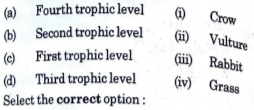All these statements about trophic levels and ecosystems are false except.
(a) Trophic level represents a functional level, not a species as such
(b) A given species never occupies more than one trophic level in the same ecosystem at the same time
(c) In most ecosystems , producers are less in number and biomass than the herbivores
(d) Pyramid of energy can never be upright .
Trophic level represents a functional level, not a species as such
A given species never occupies more than one trophic level in the same ecosystem at the same time
In most ecosystems , producers are less in number and biomass than the herbivorous
Pyramid of energy can never be upright .
The correct Answer is:A
To solve the question about which statement regarding trophic levels and ecosystems is true, we will analyze each option step by step.
1. Understanding Trophic Levels:
- Trophic levels refer to the different levels in a food chain or food web where organisms obtain their energy. Each level represents a functional role in the ecosystem, rather than a specific species.
2. Analyzing Option (a):
- Statement: "Trophic level represents a functional level, not a species as such."
- Evaluation: This statement is true. Trophic levels are defined by the role organisms play in the ecosystem (producers, consumers, decomposers), and not by specific species.
3. Analyzing Option (b):
- Statement: "A given species never occupies more than one trophic level in the same ecosystem at the same time."
- Evaluation: This statement is false. A species can occupy different trophic levels depending on its role in the ecosystem (e.g., a species can be a herbivore at one time and a carnivore at another).
4. Analyzing Option (c):
- Statement: "In most ecosystems, producers are less in number and biomass than the herbivores."
- Evaluation: This statement is false. In most ecosystems, producers (plants) are more numerous and have greater biomass than herbivores.
5. Analyzing Option (d):
- Statement: "Pyramid of energy can never be upright."
- Evaluation: This statement is false. The pyramid of energy is always upright because energy flows in one direction from producers to consumers, and energy decreases at each trophic level.
6. Conclusion:
- After evaluating all options, the only true statement is option (a): "Trophic level represents a functional level, not a species as such."
Final Answer:
The correct answer is (a) Trophic level represents a functional level, not a species as such.
- Trophic levels refer to the different levels in a food chain or food web where organisms obtain their energy. Each level represents a functional role in the ecosystem, rather than a specific species.
- Statement: "Trophic level represents a functional level, not a species as such."
- Evaluation: This statement is true. Trophic levels are defined by the role organisms play in the ecosystem (producers, consumers, decomposers), and not by specific species.
- Statement: "A given species never occupies more than one trophic level in the same ecosystem at the same time."
- Evaluation: This statement is false. A species can occupy different trophic levels depending on its role in the ecosystem (e.g., a species can be a herbivore at one time and a carnivore at another).
- Statement: "In most ecosystems, producers are less in number and biomass than the herbivores."
- Evaluation: This statement is false. In most ecosystems, producers (plants) are more numerous and have greater biomass than herbivores.
- Statement: "Pyramid of energy can never be upright."
- Evaluation: This statement is false. The pyramid of energy is always upright because energy flows in one direction from producers to consumers, and energy decreases at each trophic level.
- After evaluating all options, the only true statement is option (a): "Trophic level represents a functional level, not a species as such."
The correct answer is (a) Trophic level represents a functional level, not a species as such.
Similar Questions
Knowledge Check
Which one of the following animals may occupy more than one trophic levels in the same ecosystem at the same time?
ASparrowBLionCGoatDFrogWhich one of the following types of organisms occupy more than one trophic level in a pond ecosystem?
APhytoplanktonBFishCZooplanktonDFrog
"It is possible that a species may occupy more than one trophic level in the same ecosystem at the same time." Explain with the help of one example.
View SolutionName any two organisms which can occupy more than one trophic level in an ecosystem.
View Solutionstatement A: same organisms always occupy only one specific tophic level in a food web. statement B: a species may occupy more than one trophic level in the same ecosystem at the same time
View SolutionWhich one of the following types of organisms occupy more than one trophic level in a pond ecosystem?
View SolutionWhich one of the following types of organisms occupy more than one trophic level in a pond ecosystem?
View SolutionMatch the trophic level with their correct species examples in gressland ecosystem.

View Solution
